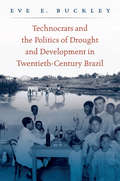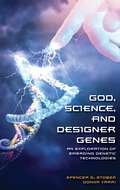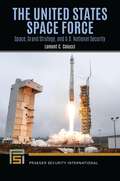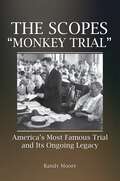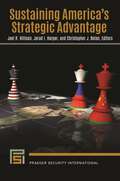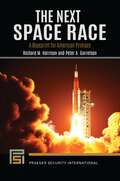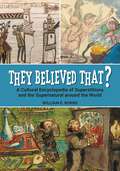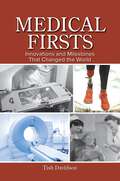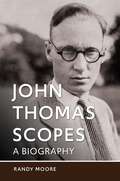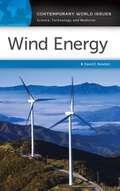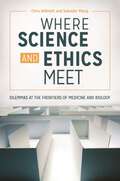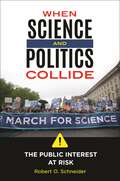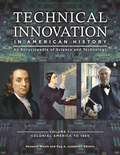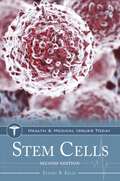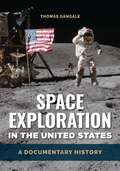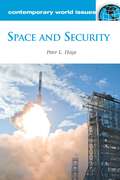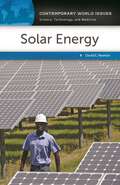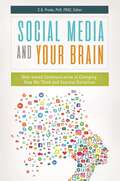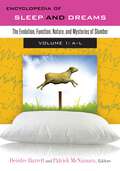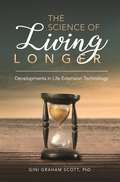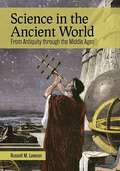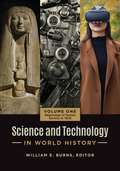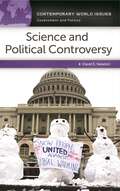- Table View
- List View
Technocrats and the Politics of Drought and Development in Twentieth-Century Brazil
by Eve E. BuckleyEve E. Buckley’s study of twentieth-century Brazil examines the nation’s hard social realities through the history of science, focusing on the use of technology and engineering as vexed instruments of reform and economic development. Nowhere was the tension between technocratic optimism and entrenched inequality more evident than in the drought-ridden Northeast sertão, plagued by chronic poverty, recurrent famine, and mass migrations. Buckley reveals how the physicians, engineers, agronomists, and mid-level technocrats working for federal agencies to combat drought were pressured by politicians to seek out a technological magic bullet that would both end poverty and obviate the need for land redistribution to redress long-standing injustices.
God, Science, and Designer Genes: An Exploration of Emerging Genetic Technologies (Non-ser.)
by Spencer S. Stober Donna YarriA biologist and a Christian theologian examine the scientific and philosophical implications and potential impacts of genetic technologies.God, Science, and Designer Genes: An Exploration of Emerging Technologies provides a unique approach to the central ethical dilemma in contemporary science, offering both an up-to-date account of the current state of genetic technologies and insightful discussions of the moral/theological questions these technologies raise.Coauthored by professors of biology and theology, God, Science, and Designer Genes examines a range of from-the-headlines issues, including the relationship between science and religion, "designing" our children, stem-cell research, cloning, genetics and behavior, genetics and privacy, and using genetic technologies for social justice. Who should benefit—personally and financially—from DNA technology? Who might be harmed? How do we protect individual rights and guard against discrimination? How will embryo modification affect the identity of those so modified? God, Science, and Designer Genes gives readers an eloquent, thoughtful, and objective foundation for considering these and other questions about the potential conflict between scientific achievement, personal faith, and social responsibility.
The United States Space Force: Space, Grand Strategy, and U.S. National Security (Praeger Security International)
by Lamont C. ColucciThe United States Space Force, the sixth branch of the armed forces, will soon play a leading role in American foreign policy and will be necessary to protect its economic, political, and social interests at home and abroad.This book argues that America's newest branch of the armed forces, the United States Space Force, will soon play a key strategic role in American foreign policy, military and economic expansion, and technological innovation. Written by a leading expert on and member of the Space Force, the book offers an introduction to the Space Force, explains the urgent need for it, and walks readers through what exactly the Space Force is and is not. Drawing on dozens of interviews with high-ranking members of the armed forces, the author claims that, in the future, space will be the geopolitical center of world politics, as such countries as the U.S., Russia, and China jockey for control of it. America must therefore set aside partisan politics to make space a top priority, as a failure to do so will leave the U.S. and its citizens in a dangerous and vulnerable position on the world stage.
The Scopes "Monkey Trial": America's Most Famous Trial and Its Ongoing Legacy (Images Of America Ser.)
by Randy MooreThis book introduces readers to the "Trial of the Century," revealing how the trial originated, what caused and happened during and after the trial, what happened to the trial's participants, and why the trial still matters nearly 100 years later.Ongoing controversies about school curricula, such as the teaching of Critical Race Theory and the role of parents in public education, can all be traced to the Scopes Trial. Today, the question remains: who controls the school curriculum? This was a foundational issue in the Scopes Trial, and we have been debating this question ever since. This book will help readers understand where these controversies originated and how courts, politicians, and the public handled these issues nearly a century ago.Featuring new information from previously untapped sources and providing an in-depth study of John Scopes himself, this book interrogates the facts, fictions, and legend of the Scopes Trial, which historians rank as one of the defining events of the 20th century. It is an ideal resource for anyone interested in the ongoing controversy about evolution, science, and religion in education and American life.
Sustaining America's Strategic Advantage (Praeger Security International)
by Joel R. Hillison, Jerad I. Harper, and Christopher J. Bolan, EditorsWritten for foreign policy practitioners, scholars, and students, this book offers critical insights into the modern landscape of international politics and warfare and explains how the United States can sustain its strategic advantages in the 21st century and beyond.From the level of grand strategy to more intricate security issues, this book explores how the United States can sustain its strategic military and political advantages around the world. Developing and implementing effective national policies; fostering strong diplomatic and geopolitical ties with allies in Europe, the Indo-Pacific, and the Middle East; and managing an effective defense enterprise are key, according to the authors, to competing on a shifting international security landscape. Advancing the literature on grand strategy and outlining emerging critical issues in security, this book offers an overarching framework for strategy; an analysis of crucial security-related topics, such as cyber warfare; and informed opinions on components of competitive success, such as irregular warfare and partner building. Written by well-respected scholars, security professionals, and foreign policy practitioners, this book goes beyond focusing on hard power to consider how the U.S. can leverage its education institutions and a worldwide network of allies and partners to sustain its strategic advantage now and in the future.
The Next Space Race: A Blueprint for American Primacy (Praeger Security International)
by Richard M. Harrison Peter A. GarretsonIf China's space ambitions continue unchallenged, America will be seriously economically and militarily disadvantaged. This book provides a comprehensive strategy to secure U.S. primacy in the space domain.From Moon landings to plans for asteroid mining, China is beginning to exploit space to achieve its great power ambitions. Its strategy could, over time, severely and adversely impact U.S. economic and military security. The United States needs to structure its approach to space to ensure that it can meet or surpass PRC timelines. Authors Richard M. Harrison and Peter A. Garretson, both from the American Foreign Policy Council, review the literature on Chinese space ambitions and assess U.S. space-related initiatives across the government, military, and private sector to understand the maturity of technology available to support space initiatives. Their first-hand research and findings are supplemented by interviews with industry experts, corporate space leaders, and government and military officials. The Next Space Race describes and seeks to influence the development of American space policy to ensure the U.S. industrial base is ready to meet or surpass PRC milestones, empower and clarify the mission of the newly minted Space Force, provide guidance to NASA and other federal agencies, and incentivize private sector companies to contribute to ensuring American space primacy.
They Believed That?: A Cultural Encyclopedia of Superstitions and the Supernatural around the World
by William E. BurnsThis encyclopedia is the perfect guide to the weird, magical, superstitious, and supernatural beliefs of people from all over the world.This book is devoted to those human beliefs that fall in the "gray zone" between science, religion, and everyday life-call them superstitious, supernatural, magical, or just wrong. In an often incomprehensible world where lightning or plague could end life quickly or drought could condemn a poor family to agonizing death, superstitious beliefs gave people a feeling of understanding or even control. They have continued to shape societies and cultures ever since.This book covers a range of superstitious, supernatural, and otherwise unusual beliefs from the ancient world to the early 19th century. More than 100 entries explain beliefs, discuss historical evidence, and explain how each belief differs across cultures. This book is a perfect gateway for anyone curious about superstitious and magical beliefs, with topics ranging from the everyday, such as dogs and iron, to legendary figures, such as Hermes Trismegistus and the Yellow Emperor.
Medical Firsts: Innovations and Milestones That Changed the World
by Tish DavidsonProfiling 60 medical innovations and milestones from the 11th through 21st centuries, this book highlights the people and stories behind these key moments while also exploring their historical context and enduring legacy.Medical Firsts: Innovations and Milestones That Changed the World brings together a carefully curated collection of turning points in the history of medicine over the last millennium. These firsts are drawn from a wide array of medical fields, from surgery to genetics, dentistry, and psychiatry. Firsts are arranged chronologically, but a thematic listing has also been included to allow readers to focus in on particular subject areas, such as trailblazing individuals, groundbreaking drugs and treatments, pioneering diagnostic tools, and life-saving medical procedures. Each entry begins with a description of how the first came to be, followed by discussion of the historical context in which it emerged and its continued impact on the world of medicine. Sources for further information are provided at the end of each entry and serve as a gateway to further study.We take many modern medical devices and techniques for granted, but everything from hypodermic needles and baby incubators to organ transplants, antibiotics, and hearing aids began simply as ideas in someone's mind. And while such concepts as formal medical education, methodical clinical trials, and universal healthcare may seem commonplace today, this wasn't always the case. In some cases, milestones centered around key people and institutions rather than technologies or ideas. Do you know who the first woman to win the Nobel Prize in Physiology or Medicine was, or where the oldest medical school still in existence resides? Medical history comes to life in this captivating volume.
John Thomas Scopes: A Biography
by Randy MooreThis is the first comprehensive, annotated biography of John Scopes, the famed defendant in the Scopes Monkey Trial. This biography uses new, never-before-published sources, photographs, and stories from untapped sources-John Scopes's family and friends.In 1967, John Scopes published his memoirs, which focused overwhelmingly on his eight-day trial and not on the rest of his life, ignoring several important events, such as his divorce and remarriage, his run for the U.S. Congress, and his challenges with his family. This volume is the first complete, annotated biography of John Scopes. It details his entire life and, where appropriate, those of his parents, siblings, wife, and children, all supported by hundreds of cited sources, quotations, and family stories.Ideal for readers with an interest in academic freedom, free speech, or the evolution-creationism controversy, this book uncovers the facts of Scopes's post-trial life, including the challenges that Scopes faced in his personal life, his conversion from a socialist to a political conservative, and his final years and death. Readers will be surprised to learn that John Scopes's life differed significantly from what has often been presented in the media.
World Energy Crisis: A Reference Handbook (Contemporary World Issues)
by David E. NewtonThis book provides a historical background for the world's current energy problems, describing how the Industrial Revolution has led us to the impending end of the "Age of Fossil Fuels," and describes possible solutions for averting a global crisis.World Energy Crisis: A Reference Handbook provides a thorough investigation of a controversial topic: our current global energy situation, and what actions should be taken to prevent a crippling fuel-supply catastrophe in the future.The book presents a historical background for current energy problems that discusses the supply and consumption of various forms of energy at different periods of history, covering the evolution of energy use in civilization beginning with human muscle power, the successive eras of mechanized industry and transportation, and our current dependence on fossil fuels. The author explains geopolitical factors regarding energy; details controversial new ways of extending the fossil fuel supply, including the exploitation of tar sands and oil shale as well as new technologies like hydraulic fracturing; and examines the various environmental concerns that are integral to extracting energy from natural resources—and the results of consuming them.
Wind Energy: A Reference Handbook (Contemporary World Issues)
by David E. NewtonWhile covering the fascinating history of wind power as a whole, this timely handbook focuses on current technological developments and the promise—and pitfalls—of wind energy as part of the world's energy future.The use of wind power for the generation of electricity holds vast potential for solving the world's energy problems, but numerous technical and social issues must be addressed before that potential can be realized. This handbook will both educate students about current issues related to wind energy and introduce the ways in which mankind has harnessed the wind through the ages. The book covers topics as diverse as early windmills in Europe, the United States, China, and the Middle East; the development of wind farms for electricity generation; and political factors involved in the development of wind energy today. Conventional wind turbine mechanics are explained, as are the technical improvements that drive modern wind turbines and other wind systems. What makes the handbook unique is that it combines hard science with perspective pieces that address topics such as potential environmental damage that can result from modern wind technology, and how recent developments in wind turbine technology hold the promise for considerably reducing the cost of this alternate energy source, making it competitive with conventional fossil fuels. Readers will be engaged by extensive discussion of the economic, political, and ethical issues raised by the expanding use of wind energy in the United States and elsewhere, and they will be intrigued by a look at what wind power can mean to the planet's energy future.
Where Science and Ethics Meet: Dilemmas at the Frontiers of Medicine and Biology
by Chris Willmott Salvador MacipThrough engaging case studies and clear explanations of the underlying science, this book makes the social impacts and ethical consequences of recent advances in biomedicine understandable for general readers.Recent biomedical discoveries promise considerable improvement in the quality of human life, but they also hold the potential to permanently alter society. Are the anticipated benefits worth the price we would have to pay for them? In Where Science and Ethics Meet: Dilemmas at the Frontiers of Medicine and Biology, a biochemist and a biomedical researcher who are highly experienced in explaining ethics for lay audiences present the most innovative advances in biomedicine and enable readers to develop their own opinions about the ethical and social consequences these technologies will bring. Each controversial topic in modern medicine and ethics is introduced through a hypothetical case study that highlights thorny ethical issues before explaining the key aspects of the science and technology involved and addressing the associated ethical considerations in detail. The interdisciplinary treatment of the topics makes the book relevant to students of science, medicine, ethics, law, and sociology as well as health care professionals.
When Science and Politics Collide: The Public Interest at Risk
by Robert O. SchneiderThis book explains why science and politics collide, why this is an especially critical problem at this precise time in U.S. history, and what should be done to ensure that science and politics coincide.The United States is waging a political war against science, and the stakes are increasing. When it comes to areas in which science and politics must interact, such as genetics, climate, and energy, there are always political interests pushing to spin the relevant science, but this becomes problematic when Americans abandon rationality for ideology or misinformation manufactured to confuse and persuade them. In a series of five contemporary examples, When Science and Politics Collide: The Public Interest at Risk makes the case that none of the ways in which science and politics currently communicate serve the public interest and that some of them actually result in great harm. It explains that whether disagreements are about climate change, vaccines, pandemics, or fracking, experimentally proven and reproducible data and evidence can save lives—and poor, politically motivated policies can doom them. The book concludes with recommendations for creating a more perfect union between scientific facts and political agendas.
Toxic Chemicals in America [2 volumes]: Controversies in Human and Environmental Health [2 volumes]
by Kelly A. TzoumisThis one-stop resource is ideal for understanding the extent to which toxic chemicals are used in U.S. industry and agriculture—impacting public health and the environment through everything from industrial solvents to children's toys.Every year, about 4 billion pounds of toxic chemicals are generated and released by U.S. industries. Do these chemicals pose a potential health threat to American families, including vulnerable groups like children and the elderly? Is their manufacture and use adequately regulated to protect both human and environmental health? Is the Chemical Safety for the 21st Century Act, signed in June 2016 by President Barack Obama with bipartisan support, truly the first major overhaul of toxic chemical regulation in 40 years to put human health first, as its supporters asserted? Or is it a fatally flawed bill that does the bidding of industry by undermining strong state environmental and public health laws, as some detractors claim?This two-volume set addresses all of those questions. Moreover, it presents and examines arguments marshaled by business interests, community leaders, scientists, activists, and lawmakers alike. It thus provides users with the information they need to accurately assess the impacts—pro and con—that industrial chemicals are having in shaping the world in which we work, eat, drink, breathe, and play.
Technical Innovation in American History [3 volumes]: An Encyclopedia of Science and Technology [3 volumes]
by Rosanne Welch and Peg A. LamphierFrom the invention of eyeglasses to the Internet, this three-volume set examines the pivotal effects of inventions on society, providing a fascinating history of technology and innovations in the United States from the earliest European colonization to the present.Technical Innovation in American History surveys the history of technology, documenting the chronological and thematic connections between specific inventions, technological systems, individuals, and events that have contributed to the history of science and technology in the United States. Covering eras from colonial times to the present day in three chronological volumes, the entries include innovations in fields such as architecture, civil engineering, transportation, energy, mining and oil industries, chemical industries, electronics, computer and information technology, communications (television, radio, and print), agriculture and food technology, and military technology.The A–Z entries address key individuals, events, organizations, and legislation related to themes such as industry, consumer and medical technology, military technology, computer technology, and space science, among others, enabling readers to understand how specific inventions, technological systems, individuals, and events influenced the history, cultural development, and even self-identity of the United States and its people. The information also spotlights how American culture, the U.S. government, and American society have specifically influenced technological development.
Stem Cells (Health and Medical Issues Today)
by Evelyn B. KellyThis accessibly written book explores the different types of stem cells, their current and potential future medical applications, and the many controversies that surround their creation and use.Whether from adults or embryos, stem cells have the potential to develop into many other types of cells—an ability that makes them potentially invaluable for curing a wide variety of diseases and disorders. And while some stem cell treatments are already in use today and have achieved remarkable results, the use of such cells continues to be clouded in controversy.This second edition of Steam Cells offers a wealth of new information and features. Coverage of research breakthroughs in the past decade has been added, including descriptions of recently discovered types of stem cells and stem cell therapies. In addition to addressing ethical and scientific controversies, the book also addresses issues such as the discrepancy between the public's expectations for regenerative medicine and current medical realities. Also new in this edition is a collection of case studies, each of which helps to make the topics discussed in the book more accessible to readers.
Space Exploration in the United States: A Documentary History
by Thomas GangaleThis select volume of historical documents is organized chronologically, spanning from 1914 to the present. Divided into eight chapters, it includes a narrative introduction to each historical period.This collection of historical documents provides insight into the history of the United States in its pursuit of the peaceful uses of outer space, with emphasis on the manned space program of the National Aeronautics and Space Administration, as well as commercial American activities supporting human spaceflight in the early 21st century. Rocketry and space technology have served varied goals throughout the Space Age: pure research, as well as research applied for national security, national prestige, and commercial profit. There have been varied actors as well, among them individuals supported by philanthropists as well as governments, intergovernmental organizations, international consortiums, and for-profit corporations. This book focuses on space exploration, and in particular, human space exploration, leading to the questions, "Why have humans gone into outer space in the past?" and "Why will they do so in the future?" These documents help readers to examine the variety of fascinating answers to those questions.
Space and Security: A Reference Handbook (Contemporary World Issues)
by Peter L. HaysThis thorough examination of the roots and motivations for U.S. national security space policy provides an essential foundation for considering current space security issues.During the Cold War era, space was an important arena for the clashing superpowers, yet the United States government chose not to station weapons there. Today, new space security dynamics are evolving that reflect the growing global focus upon the broad potential contributions of space capabilities to global prosperity and security.Space and Security: A Reference Handbook examines how the United States has developed and implemented policies designed to use space capabilities to enhance national security, providing a clear and complete evaluation of the origins and motivations for U.S. national security space policies and activities. The author explains the Eisenhower Administration's quest to develop high-technology intelligence collection platforms to open up the closed Soviet state, and why it focused on developing a legal regime to legitimize satellite overflight for the purposes of gathering intelligence.
Solar Energy: A Reference Handbook (Contemporary World Issues)
by David E. NewtonThis book provides an outstanding single-volume resource on the topic of solar energy for young adults and general audiences.While how much longer the world's supply of fossil fuels will last is debatable, it is a fact that the fossil fuels that we depend on so heavily today are non-renewable resources that will inevitably be exhausted—making the need to shift to alternative sources of energy such as solar extremely important. Solar Energy: A Reference Handbook presents encyclopedic coverage of the social, political, economic, and environmental issues associated with the development and use of solar energy in the United States and around the world. This book provides an in-depth description of the ways solar power has been used for at least 2,000 years. It outlines how humankind has utilized various forms of energy from the sun by way of photovoltaic cells, concentrating or focusing solar power, active and passive solar heating, and other mechanisms; and provides perspectives on today's solar energy issues from a variety of subject experts. Readers will better understand not only the advantages and disadvantages of solar power but also the critical nature of energy production to sustaining life on earth, thereby underscoring the importance of developing solar power and other alternative sources of energy to meet the world's energy needs in coming decades. The book also includes profiles of key individuals and organizations related to the field of solar energy, a chronology of important events in the history of solar energy, and a glossary that defines the key terms used in discussing the topic of solar energy.
Social Media and Your Brain: Web-Based Communication Is Changing How We Think and Express Ourselves
by C. G. PradoWhile society has widely condemned the effects on preteens and teens' natural social maturation of digitally enabled communication, such as texting and messaging, and of social media apps, such as Facebook, Instagram, and SnapChat, these forms of communication are adversely affecting everyone, including adults. This book examines how social media and modern communication methods are isolating users socially, jeopardizing their intellectual habits, and, as a result, decreasing their chances of achieving social and professional success.The ubiquitous use of the Internet and social media is changing our society—in some ways, for the worse. Use of social media, the Internet, and other purely digital and less-personal communication methods are distorting the intellectual and social maturation of teens and preteens in particular—those among us who were born into and raised with Internet technology. People's ability to read facial expressions, interpret subtle differences in spoken intonation, and perceive body language is in significant decline due to the use of social media and the Internet largely replacing direct, face-to-face contact with other human beings. This book documents how changes in our daily behavior caused by the proliferation of social media are reshaping individuals' personalities and causing an evolution of the character of our society as a whole. Readers will understand how these important changes came about and how more connectivity all too often leads to more ignorance and less comprehension, and will consider solutions that could counter the negative effects of being "too connected, too often."
Encyclopedia of Sleep and Dreams [2 volumes]: The Evolution, Function, Nature, and Mysteries of Slumber [2 volumes]
by Deirdre Barrett and Patrick McNamaraThis fascinating reference covers the major topics concerning dreaming and sleep, based on the latest empirical evidence from sleep research as well as drawn from a broad range of dream-related interdisciplinary contexts, including history and anthropology.While many books have been written on the subject of sleep and dreams, no other resource has provided the depth of empirical evidence concerning sleep and dream phenomena nor revealed the latest scientific breakthroughs in the field.Encyclopedia of Sleep and Dreams: The Evolution, Function, Nature, and Mysteries of Slumber explores the evolution, nature, and functions of sleep and dreams. The encyclopedia is divided into two volumes and is arranged alphabetically by entry. Topics include nightmares and their treatment, how sleep and dreams change across the lifetime, and the new field of evolution of sleep and dream. While this book includes ample material on the science of sleep and dreams, content is drawn from a broad range of disciplinary contexts, including history and anthropology.
The Science of Living Longer: Developments in Life Extension Technology
by Gini Graham Ph.DThis thought-provoking book looks at humanity's quest for immortality and examines the latest research on extending one's life and possibly living forever, presenting an overview of technological innovations such as cryonics, cell rejuvenation, organ transplants, using an exoskeleton, and brain transplants.With the seemingly limitless potential of 21st-century technology, the chance of human immortality being an actual possibility rather than a science fiction concept is tantalizingly close. And with this increased possibility of achieving immortality, a growing community of people interested in immortality has formed worldwide. Organizations dedicated to great extension of human life now exist, focusing on technologies that reverse the damage caused by aging, transfer human consciousness to an artificial body, or cryogenically freeze those who hope to be brought back to life when technology to revive the body without cellular damage is developed.The Science of Living Longer: Developments in Life Extension Technology provides a fascinating look at the current state of the scientific research on how people can live significantly longer—and possibly even forever. The book begins with an introductory section on the historical efforts to achieve immortality in Western and other cultures. Following chapters investigate different strands of research toward the common objective of achieving a longer life or even immortality. Other chapters address topics such as the health, wellness, and fitness movement designed to help individuals live longer; the biological methods—such as cell rejuvenation—designed to defeat aging; and the use of technology to provide an exoskeleton as body parts age or to download the brain into a computer or other body. Each chapter also suggests steps an individual can take to live longer, too.
Science in the Ancient World: From Antiquity through the Middle Ages
by Russell M. LawsonScience in the Ancient World presents a worldwide history of science, from prehistoric times through the medieval period. It covers Europe, Africa, Asia, and the Americas and includes topics ranging from alchemy and astrology to psychology and physics.This work spans prehistory to 1500 CE, examining thousands of years of history in four world regions: Asia, Africa, Europe, and the Americas. Highlights of this period include the onset of civilization and science in Mesopotamia and Egypt, the accomplishments of the ancient Greeks between 700 BCE and 100 CE, the adaptation of Greek science by the Romans, the spread of Greek science during the Hellenistic Age, the expansion of Islamic power and commensurate scientific knowledge, and the development of science and philosophy in ancient China and India.Focusing on the history of the science that blossomed in the above regions, scientific disciplines covered include alchemy, astronomy, astrology, agriculture, architecture, biology, botany, chemistry, engineering, exploration, geography, hydraulics, institutions of science, marine science, mathematics, medicine, meteorology, military science, myth and religion, philosophy, philosophy of science, psychology, physics, and social sciences. In all of these fields, theory and application are explored, as are leading individuals and schools of thought, centers of intellectual activity, and notable accomplishments and inventions.
Science and Technology in World History [2 volumes]: [2 volumes]
by William E. BurnsThis encyclopedia offers an interdisciplinary approach to studying science and technology within the context of world history. With balanced coverage, a logical organization, and in-depth entries, readers of all inclinations will find useful and interesting information in its contents.Science and Technology in World History takes a truly global approach to the subjects of science and technology and spans the entirety of recorded human history. Topical articles and entries on the subjects are arranged under thematic categories, which are divided further into chronological periods. This format, along with the encyclopedia's integrative approach, offers an array of perspectives that collectively contribute to the understanding of numerous fields across the world and over eras of development. Entries cover discussions of scientific and technological innovations and theories, historical vignettes, and important texts and individuals throughout the world. From the discovery of fire and the innovation of agricultural methods in China to the establishment of surgical practices in France and the invention of Quantum Theory, this encyclopedia offers comprehensive coverage of fascinating topics in science and technology through a straightforward, historical lens.
Science and Political Controversy: A Reference Handbook (Contemporary World Issues)
by David E. NewtonA shrewd and compelling examination of how political figures throughout history have used scientific findings to achieve their objectives—just as scientists have often put political forces to work to achieve their own goals.The U.S. government has historically been the engine of American scientific achievement, from the birth of nuclear technology to the "space race." However, at times, our government has also misrepresented scientific evidence to advance a political agenda. Science and Political Controversy: A Reference Handbook examines how the government has facilitated research for the public good and the ways in which politicians have manipulated data to serve political ends around a broad array of controversies, from stem cell research to energy development, chemical health risks, and climate change.Written specifically for high school students and general readers without specialized background knowledge on the subject, the work presents perspective essays authored by representatives from governmental agencies, politicians, political scientists, experts in the physical and life sciences, and other stakeholders concerned with the intersection of politics and science. The first section of the book provides background information on the topic that overviews the current problems and issues related to the interaction of science and politics. The second section supplies resources that readers can use for their own research, such as an annotated bibliography, profiles of important individuals and organizations, a chronology of important events, and a glossary of key terms.
